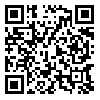BibTeX | RIS | EndNote | Medlars | ProCite | Reference Manager | RefWorks
Send citation to:
URL: http://ijml.ssu.ac.ir/article-1-61-en.html
Background and Aims: Aspergillus fumigatus is a sporadic fungus that causes different infections and allergies in immunocompromised patients. The allergic disease caused by this fungus is called allergic bronchopulmonary aspergillosis (ABPA). ABPA is considred important in atopic and immunocompromised individuals, which can result in inflammation and epithelial damage. Therefore, the aim of this study was to evaluate the T helper (Th)2 responses in a ABPA murine model by measuring the main cytokines involved in Th2.
Materials and Methods: Twenty male BALB/c mice were divided into two groups of 10 mice each: control and ABPA group. ABPA was induced by inhalation of A. fumigatus conidia intranasally. Total and specific IgE were measured in the mice sera. Levels of cytokines in broncho alveolar lavage (BAL) of under studied groups were measured by Enzyme-linked immunosorbent assay three weeks after the treatment.
Results: The obtained results indicated that total and specific IgE increased in the ABPA group (p<0.05). The levels of Interleukin (IL)-4, IL-5 and IL-13 in brocho alveolar lavage of ABPA group was significantly higher than the control group (p<0.05), whereas interferon-gamma levels did not reveal any significant differences between the studied groups.
Conclusions: The findings of the present study confirmed the role of Th2 cytokines in the ABPA reactions. However, more comprehensive studies are necessitated to determine the exact mechanisms of immune responses to ABPA as well as the role of Th1/Th2 responses in control of ABPA reactions. Regulation of Th2 responses could be regarded as a potential therapy for ABPA as well.
Received: 2015/11/25 | Accepted: 2015/11/25 | Published: 2015/11/25
| Rights and permissions | |
 |
This work is licensed under a Creative Commons Attribution-NonCommercial 4.0 International License. |





